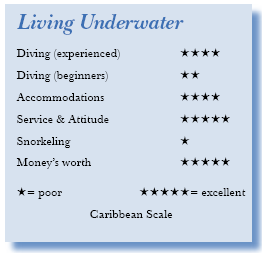Valet Diving in CozumelContents of this Issue: Should We Dive with Overfilled Tanks? The Certified Diver’s Handbook They Sting, Itch, and Raise Angry Welts The Plot for Your Next Pulp Fiction Novel UWATEC Settles Over Dive Computer Editorial Office: Ben Davison Publisher and Editor Undercurrent 3020 Bridgeway, Suite 102 Sausalito, CA 94965 — relax and go with the flow from the May, 2005 issue of Undercurrent
Dear Fellow Diver: “The hardest part of diving the Devil's Throat is getting past the tonsils.” Those were Jeremy Anschel's words before we backrolled off his Living Underwater dive boat at Punta Sur, Cozumel. Once on the bottom, he led my buddy and me through a narrow hole into a cramped black cave — the devil's tonsils. Barely keeping track of his fins in the murk, I followed Jeremy until I spotted light coming from below us. Jeremy slid over the edge of the cave at 90 feet into a tunnel — the devil's throat — and began descending toward the light. I followed him down. At 127 feet I exited into blue-water with 100-foot visibility. Finally turning on my dive light, I ignited a riot of color on the lush, overgrown walls. Jeremy took me into another cave, the Cathedral, with a natural white coral cross on one wall. We exited and he pointed out the Devil's Eyes, two openings in the wall with sunlight streaming spectrally through them. By that point my computer had gone into decompression mode. With Jeremy leading, my buddy and I wove our way slowly up the wall until my computer was out of deco. A half-dozen barracudas entertained us as we glided along the reef top on our final 15-foot safety stop. The Devil's Throat has become one of Cozumel's signature dives. Not all dive operators go there, partially because of its remote location near the southern end of Cozumel's western shore. But, it's also a decompression dive. That's one reason I'd chosen Living Underwater, which offers a unique combination of advanced diving with “valet” service, meaning maximum adventure with minimum hassles. They also use 120 cu. ft. and 95 cu. ft. steel tanks for extended bottom times. My Devil's Throat deco dive, for instance, had lasted 64 minutes. Shortly after arriving at the Hotel Cozumel & Resort in early January, I met Jeremy in the lobby to fill out his paperwork and so he could collect my gear (even wetsuit), and have it ready on his boat the following morning. The hotel, formerly called Las Brisas, is on Avenida Rafael Melgar, the waterfront road that leads into the picturesque town of San Miguel. It's a full scale resort, with Cozumel's largest pool, a stage for outdoor entertainment, tennis courts, ping pong tables, and workout equipment and can be booked on an inclusive or European plan basis. It allows pickups by other dive operators. To get the beach, I strolled through a tunnel under the Avenida to the Club de Playa. On the beach, the club has its own bar, buffet, small shallow pool, lounge chairs, and steps to the water by a boat dock. Here, Dive Paradise has its own boats and offers gear lockers and fresh water rinse facilities. That night my buddy and I ate in the Hotel Cozumel's sparsely patronized dining room. Our meals were eclectic and hearty but undistinguished, and the only white wine (Calafia, from Baja California) drove my wine snob buddy into the frosty embrace of a Dos Equis. Our spacious, air-conditioned room had two double beds, a writing table with two wicker chairs, and a secure sliding-glass door to a balcony facing the ocean, with dive gear drying pegs and a table and chairs. Our cable TV pulled in some programs in English. I put down a deposit for a key to the safe in our closet and another for the TV remote and settled in. Our stuff stored easily in 3-drawer bureaus, as well as the closet. The next morning at 8:00 a.m., Jeremy and his captain, Francesco, were waiting at the hotel dock in Living Underwater's 7-passenger, 28-ft. dive boat, powered by twin Yamaha 150 hp outboards. We headed out to dive while most other operations were still loading passengers and gear. Since we were his only guests, Jeremy asked for requests, and I responded with “the splendid toadfish,” the notoriously reclusive creature endemic to Cozumel. “How many would you like to see?” Jeremy asked, then ordered Francesco to take us to a site called Tormentos. The speedy LU boat is equipped with a fly-bridge and small square shade panel amidships. There's a tiny forward cabin for dry storage, but no head. Jeremy gave us cushions for the bumpy, and sometimes wet, ride. My tank had been set up, so I slipped on my wetsuit and Francesco helped me into my BCD with tank. With Francesco's help, I stood with the big 120 cu. ft. steel tank, awkwardly raising it over a lip on the gunwale. Then my buddy and I backrolled into the water. Jeremy led us on a gentle drift in less than one-knot current. A 3- 1/2' foot barracuda hovered under a ledge. A 5' spotted eagle ray had a piggybacking remora, and they were followed by a 3' dog snapper. I saw huge gray angels, a motorcycle gang of durgons in their shiny black jackets, and gruff bi-color damselfish defending their territory like Nemo wannabes. A sand diver darted out of his hole to attack Jeremy's finger. And Jeremy pointed out one splendid toad in a hole. When I signaled that I was down to 700 psi, Jeremy uncoiled a surface marker buoy so Francesco could follow our drift. As we coasted along, he slowly reeled in at 5' increments until we reached our safety stop depth. Toward the end of the 84-minute dive, I got chilled, despite the 79° F. water. That, I realized, was one downside of using larger tanks. Another? After my second day of diving with the heavy steel 120, my back began to ache. The discomfort continued throughout my stay and lasted for two months after returning. Jeremy's routine includes settling on the sand for several minutes at the beginning of most dives to crank down everyone's metabolism. Then, the final 15 minutes or so are spent drifting under the SMB, usually several feet above the reef. So we logged bottom time, but not all of it quality time. To further increase bottom time, he overfills his 2,400 psi-rated tanks to 3,000 psi to give his divers 25 percent more air. This practice alarmed me, as did signs of rust I spotted above the tank boots. He dismissed my concerns, but further research convinced me that he may be taking greater risks than he realizes (see sidebar). Upon reaching the side of the boat, we hung onto a nylon line and my buddy doffed her weight belt and scuba rig, passing them up through a gate to Francesco while Jeremy climbed on board. Then she worked her way along the line back to the ladder near the stern, where she handed up her fins before climbing aboard. Francesco removed the BCD and regulator from her tank before taking mine, and with the combination of current and surface chop, I was frequently banged against the boat while waiting my turn. I couldn't imagine going through this routine with seven divers. On board, Jeremy offered warm towels, bottled water and fruit, and fleece-lined parkas. Then, off for a long surface interval at a beach club called Playa Corona to order lunch. Ever the doting host, Jeremy brought fish ID books to the table and answered my questions with great patience. A native of Minnesota, he had worked for Cozumel's Aldora Divers and then for Living Underwater, which he bought three years ago. On our afternoon dive at Las Palmas, Jeremy produced three splendid toadfish, one with his gaudy, painted face fully visible. I also spotted tile fish, box fish, slipper lobster, a fire worm crawling on the sand, a ton of Pixar-pretty tropicals, and arrow crabs lounging in vase sponges. On another day at Palancar Bricks, I tooled along a glorious jumble of
hard and soft corals studded by a rainbow of sponges and faceted by grottoes,
tunnels, and overhangs. This site was more sumptuous than anything
I've seen in Grand Cayman or the Bahamas, and reminded me of Manta Wall at
Belize's Lighthouse Reef. When other divers emerged from a swim-through, we slipped through a cut to the side
of the reef they had just vacated. Palancar Caves offered equally spectacular topography as Jeremy led us through an underwater fun-house of swimthroughs. In the sand around the caves he found a banded jawfish and a 16-inch furry sea cucumber, which he stroked into such a relaxed state we were all able to handle and caress its limp body, studded with thousands of suckers on its underside. The ever-popular Palancar Reef has so many great sites I could have dived it exclusively. I was disappointed, however, in one dive, the well-advertised C-53 wreck (or “Felipe Xicotencatl”), a 200-foot minesweeper intentionally sunk in 2000. It has little marine encrustation or vertebrate life and the rooms have been so “sanitized” for safe diving, it was impossible to tell what most of them had once been. We did eight dives in four days with Living Underwater, sometimes too pooped to do any more (the longest, at Palancar Caves, lasted 93 minutes with a max depth of 89 fsw). Three days we were the only passengers. On the last, tired, I asked Jeremy to pick us up at 10:30 instead of 8-ish. That timing worked great, as the divers from the other boats were on their surface intervals when we got to our first site. My first visit to Cozumel was in the mid-70s, and even back then, I considered it a diving cliché. Returning in 2005, I was amazed at how well the reefs have held up, how good the diving is, the terrific atmosphere, and the comparatively low prices. It won't be another 30 years before I return. P.S.: Aldora Divers will soon have boats and equipment at the Hotel Ventanas al Mar on the unexplored east side of the Island. Here are walls with numerous sharks and old Spanish wrecks, where the occasional cannon and even doubloons are still found. This will not be easy diving and conditions may cause postponements, but it offers unique underwater adventure. For reservations, e-mail info@cozumelwindward.com. — D.L. |

I want to get all the stories! Tell me how I can become an Undercurrent Online Member and get online access to all the articles of Undercurrent as well as thousands of first hand reports on dive operations world-wide
| Home | Online Members Area | My Account |
Login
|
Join
|
| Travel Index |
Dive Resort & Liveaboard Reviews
|
Featured Reports
|
Recent
Issues
|
Back Issues
|
|
Dive Gear
Index
|
Health/Safety Index
|
Environment & Misc.
Index
|
Seasonal Planner
|
Blogs
|
Free Articles
|
Book Picks
|
News
|
|
Special Offers
|
RSS
|
FAQ
|
About Us
|
Contact Us
|
Links
|
3020 Bridgeway, Ste 102, Sausalito, Ca 94965
All rights reserved.

 They
approached two hawksbill turtles, so
Jeremy signaled us to hover, and soon
they spooked one of the turtles toward
us — seems he knows diver behavior as
well as he knows his marine life.
They
approached two hawksbill turtles, so
Jeremy signaled us to hover, and soon
they spooked one of the turtles toward
us — seems he knows diver behavior as
well as he knows his marine life. Diver's Compass: Living Underwater can be reached at 011 52
987 869 1813, or e-mail
Diver's Compass: Living Underwater can be reached at 011 52
987 869 1813, or e-mail 